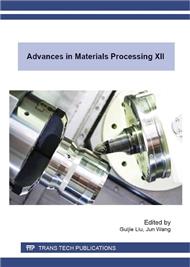p.182
p.189
p.195
p.201
p.207
p.216
p.222
p.229
p.236
An Investigation of Hot Forging Die Wear Based on FEA
Abstract:
Taking the forging die of an automobile differential shell as example, the influence of some die forging process parameters and die structure parameters on the die wear was investigated. Based on a modified Archard wear model and the application of finite element method simulation, the die wear depth was calculated under a steady state temperature field. Within the scope of the experimental data, the research shows that: with the increase of billet preheating temperature, the wear is reduced gradually. Improving die preheating temperature, the wear increases gradually. When the forming speed is 300mm/s~400mm/s, the wear value decreases first and then increases.When the forming speed is over than 400mm/s, the change of wear value is not obvious. Increasing flash thickness and round radius, the wear value reduces gradually.
Info:
Periodical:
Pages:
207-215
Citation:
Online since:
July 2016
Authors:
Keywords:
Price:
Сopyright:
© 2016 Trans Tech Publications Ltd. All Rights Reserved
Share:
Citation:


